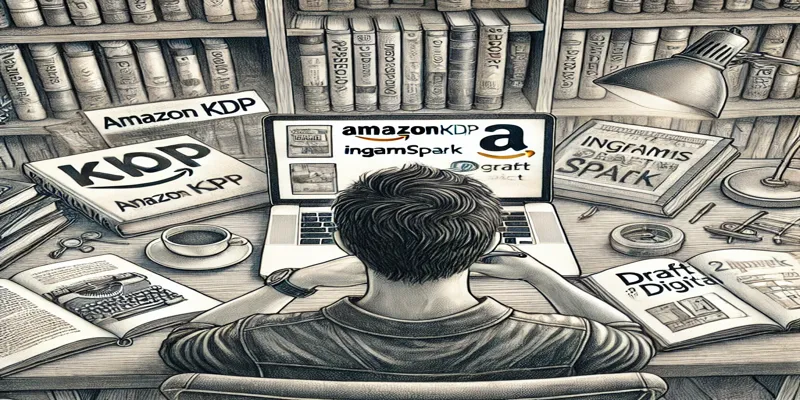Why Choosing the Right Platform Matters
Self-publishing is an exciting journey, but with so many platforms available, it can be overwhelming to decide where to publish. Each platform has its own strengths, royalties, and distribution options and choosing the wrong one could mean losing potential sales or limiting your audience reach.
📚 Why does platform choice matter?
✔ Determines where and how your book is sold.
✔ Affects royalties and pricing flexibility.
✔ Impacts marketing and promotional opportunities.
✔ Defines print, ebook, and audiobook distribution options.
This guide will break down the top self-publishing platforms, their pros and cons, and how to choose the best fit for your book and goals.
Understanding the Different Types of Self-Publishing Platforms
Before choosing, it’s important to know that self-publishing platforms generally fall into three main categories:
1️⃣ Exclusive vs. Wide Distribution
✔ Exclusive (Amazon KDP Select) – Your ebook is only sold on Amazon. You get higher royalties (70%) and Kindle Unlimited (KU) access, but you can’t sell elsewhere.
✔ Wide Distribution – You publish on multiple platforms (Apple Books, Google Play, Kobo, etc.), reaching more readers worldwide.
📌 Pro Tip: If you’re just starting, Amazon KDP is a great place to begin. You can always go “wide” later.
2️⃣ Print-On-Demand (POD) vs. Ebook-Only Platforms
✔ Print-on-Demand (POD): Lets you sell paperback & hardcover copies without inventory costs. (Example: KDP Print, IngramSpark)
✔ Ebook-Only: Focuses only on digital books. (Example: Apple Books, Google Play, Draft2Digital)
📌 Pro Tip: If you want bookstores and libraries to carry your book, choose a platform that distributes to Ingram (like IngramSpark or Draft2Digital).
3️⃣ Full-Service vs. DIY Platforms
✔ DIY Platforms – You upload, format, and market the book yourself. (Example: Amazon KDP, IngramSpark)
✔ Full-Service Platforms – They handle everything, but charge fees or take a bigger royalty cut. (Example: BookBaby, Lulu)
📌 Pro Tip: If you’re on a budget, DIY is the way to go it gives you full control and higher earnings.
Top Self-Publishing Platforms (Pros & Cons)
Now that you understand the basics, let’s compare the best self-publishing platforms based on features, pricing, and distribution.
1️⃣ Amazon Kindle Direct Publishing (KDP) – Best for Ebook & Print
📌 Why Choose KDP?
✔ Biggest Ebook Market (80%+ of all ebook sales).
✔ Kindle Unlimited (KU) Program – Higher exposure.
✔ Print-On-Demand (POD) for paperbacks.
❌ Drawbacks:
✖ KDP Select restricts you from selling elsewhere.
✖ Limited bookstore & library distribution.
📌 Best For: Authors who want to focus on Amazon sales & Kindle readers.
2️⃣ IngramSpark – Best for Print & Bookstore Distribution
📌 Why Choose IngramSpark?
✔ Distributes to bookstores & libraries worldwide.
✔ Offers hardcover printing options.
✔ Better quality printing than Amazon KDP.
❌ Drawbacks:
✖ Setup fees (though promo codes sometimes waive them).
✖ Higher print costs than KDP Print.
📌 Best For: Authors who want their book available in bookstores & libraries.
3️⃣ Draft2Digital – Best for Wide Ebook Distribution
📌 Why Choose Draft2Digital?
✔ Distributes to multiple platforms (Apple, Kobo, Barnes & Noble).
✔ Auto-formatting & easy setup.
✔ No upfront fees (takes a small % of sales).
❌ Drawbacks:
✖ Doesn’t distribute to Amazon (you must upload separately).
✖ Limited marketing tools compared to Amazon KDP.
📌 Best For: Authors who want to go wide with minimal effort.
4️⃣ Apple Books – Best for Apple Users
📌 Why Choose Apple Books?
✔ Strong presence in the Apple ecosystem.
✔ Higher royalties (up to 70%) without exclusivity.
✔ Great for fiction, romance, and business books.
❌ Drawbacks:
✖ Requires a Mac to publish directly.
✖ Less market share than Amazon.
📌 Best For: Authors with a strong Apple audience.
5️⃣ Google Play Books – Best for Search Engine Visibility
📌 Why Choose Google Play?
✔ Your book appears in Google search results.
✔ No exclusivity requirements.
✔ Expanding global audience.
❌ Drawbacks:
✖ Difficult pricing structure (Google may discount your book).
✖ Smaller market share than Amazon & Apple.
📌 Best For: Authors looking for organic discovery via Google searches.
How to Choose the Best Platform for Your Goals
1️⃣ Ask Yourself These Key Questions:
✔ Do I want to sell exclusively on Amazon or go wide?
✔ Do I need paperback & hardcover printing?
✔ Will I be marketing my book myself, or do I need extra support?
✔ Do I want global distribution or a more targeted approach?
📌 Example:
✔ If you’re focused on Kindle sales, go with Amazon KDP Select.
✔ If you want your book in bookstores & libraries, use IngramSpark.
✔ If you prefer wide distribution, try Draft2Digital + Google Play.
Maximizing Your Book Sales on Any Platform
1️⃣ Optimize Your Book Listing
✔ Use SEO-friendly keywords in your title & description.
✔ Select the right categories to increase discoverability.
✔ Add high-quality book cover & professional formatting.
2️⃣ Run Strategic Promotions
✔ Leverage Amazon’s free & countdown deals.
✔ Use BookBub, Bargain Booksy, and Freebooksy for advertising.
✔ Encourage early reviews to boost rankings.
📌 Pro Tip: Reviews increase book visibility, so ask for honest feedback from ARC (Advanced Reader Copy) readers.
The Right Platform Can Make or Break Your Book’s Success
Choosing a self-publishing platform is one of the most important decisions an author makes. Whether you choose Amazon KDP, IngramSpark, or a combination of platforms, the key is to understand your audience and distribution goals.
🚀 Your Next Steps:
✔ Decide whether to sell exclusively or go wide.
✔ Research the best platform based on your book format (ebook, print, or audiobook).
✔ Optimize your book metadata, marketing, and pricing strategy.
What platform are you considering for your book? Let’s discuss your publishing goals in the comments! 📚🔥

